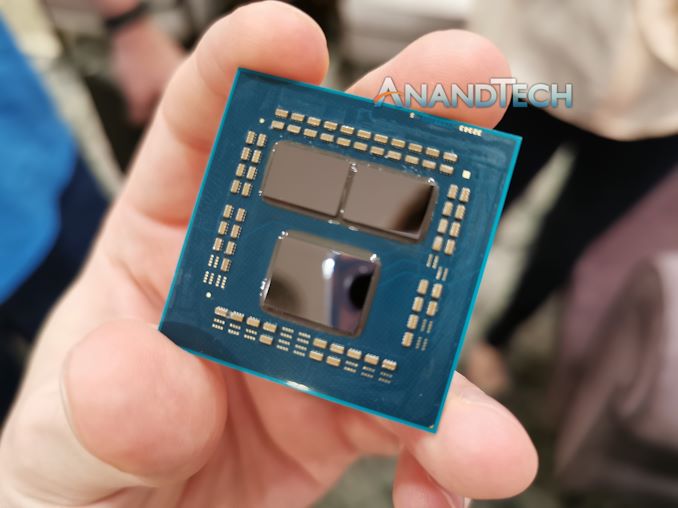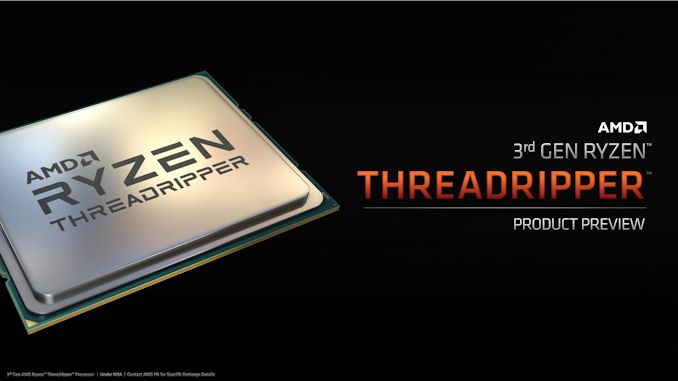AMD Q4: 16-core Ryzen 9 3950X, Threadripper Up To 32-Core 3970X, Coming November 25th
by Dr. Ian Cutress on November 7, 2019 9:00 AM EST
AMD is set to close out the year on a high note. As promised, the company will be delivering its latest 16-core Ryzen 9 3950X processor, built with two 7nm TSMC chiplets, to the consumer platform for $749. Not only this, but AMD today has lifted the covers on its next generation Threadripper platform, which includes Zen 2-based chiplets, a new socket, and an astounding 4x increase in CPU-to-chipset bandwidth.
This year AMD is presenting its ‘Fall 2019 Desktop Update’, covering the new products for the holiday season. Q4 is historically a good target for increased consumer sales, as long as the products hit the right price point and are available in volume for the peak shopping periods. We’ve been waiting mercilessly for more details about the crème-de-la-crème of what AMD has to offer with its 7nm product portfolio for both mainstream Ryzen desktop processors, but also the creator and workstation focused 3rd Gen Threadripper. After continuously requesting information from CEO Lisa Su since the middle of the year, AMD is lifting the lid on the product details, pricing, and launch dates.
The short version of today’s announcement revolves around several parts, in completely different markets.
- The Ryzen 9 3950X 16-core CPU for desktops
- Ryzen Threadripper 3rd Gen Family: Starting with the 24-core 3960X and 32-core 3970X
- New TRX40 motherboards for the new Threadripper Processors
- A new $49 Athlon 3000G for the entry level market
All of this hardware is set to come to market through the month of November at the following dates:
- Ryzen 9 3950X: Retail on November 25
- TR 3960X and TR 3970X on November 25th
- TRX40 motherboards on November 25th
- Athlon 3000G on November 19th
One key takeaway from today’s announcements is how AMD is moving the traditional desktop and high-end desktop markets. When CEO Dr. Lisa Su was asked earlier this year what will happen to Threadripper as the mainstream Ryzen family moves ‘up’ in performance, her response was that ‘Threadripper will move up-up’. To that effect, we are seeing AMD’s delineation between mainstream desktop and high-end desktop move up to between 16-core and 24-core, with room at the top for more cores if AMD wants to go that way.

Our Group Interview with Dr. Lisa Su at Computex 2019
This new hardware is also breaking new records for enthusiast CPU TDP values, as well as representing new ground on the latest 7nm process technology now available to the wider market. Details about pricing, TDP, AMD’s strategy, AMD’s performance numbers, TRX40 chipset information, and analysis of the announcements are all inside.












171 Comments
View All Comments
Death666Angel - Thursday, November 7, 2019 - link
What are you talking about? A short trip to "geizhals.de" shows 16 mini ITX AM4 motherboards available, 3 X570, 2 X470, 3 X370, 4 B450, 3 B350 and 1 A320. There is even an mini STX motherboard, if you want to buy a whole barebones PC (DeskMini A300).And a smart TV has the smart stuff integrated. You are talking about an HTPC.
Midwayman - Thursday, November 7, 2019 - link
I really wish all the PCIe lanes were available at lower core counts. Its not hard to have a lot of I/O needs without needing a stupid amount of cores. It really sucks when you go to install an expansion card or NVME only to find out that its going to drop your GPU lanes from 16x to 8x.DigitalFreak - Thursday, November 7, 2019 - link
My understanding is that Ryzen actually has 32 PCIe lanes available on the processor, at least in the 1xxx and 2xxx series. They only exposed 24 of them (16 GPU, 4 NVMe, 4 to the chipset) for some reason. Limitation of the socket?John_M - Friday, November 8, 2019 - link
It is obviously limited by the AM4 socket, though not arbitrarily - it was a conscious design choice. Some of them are used internally bt the SoC for SATA, USB, etc. Actually, If you take a look at Raven Ridge and Picasso all 32 lanes are indeed used: 8 to the discrete GPU slot, 4 for NVMe, 4 to the chipset and 16 to the integrated GPU, SATA, USB, etc.Kevin G - Thursday, November 7, 2019 - link
Kind of irked that there is a new socket for TR. The Epyc side didn't need a new socket for PCIe 4.0 and that invoked a few changes too (like an additional PCIe lane for OoBM). At the very least, it would have been nice to have had the 3rd gen TR parts work in earlier motherboards for an upgrade path even if that meant that the IO was PCIe 3.0 only and the chipset link was effectively 4x PCIe 3.0. The centralized IO chip is likely a huge reason for the generational performance leap on top of the Zen2 improvements. That's something original socket TR4 owners probably want.DigitalFreak - Thursday, November 7, 2019 - link
Realistically, how many people actually upgrade a CPU without upgrading the motherboard? That argument is getting old.TheinsanegamerN - Thursday, November 7, 2019 - link
so old. I have never upgraded a CPU only, because motherboard features have always been just as important.Death666Angel - Thursday, November 7, 2019 - link
What are the benefits you got from your motherboard after upgrading from a Z170 to a Z390 motherboard?Let's look at the Asus Z170-P and the Asus Z390-P:
4 DDR4 DIMM slots
x16 and x4 GPU slots
Z170 has 2 PCIe x1 & 2 PCI slots vs Z390 4 PCIe x1 slots
Z390 has 2 NVME slots (x2/SATA + x4) and wifi M.2 vs Z170 has 1 NVME x4 slot
Z170 has USB C on the IO vs Z390 not but Z390 has more USB ports in general (other Z170 have more USB) and Z390 has USB 3.1 (10 Gbps)
Z390 has RGB and a water pump header
That is not a lot of features you gain for a product that launched in 2015 vs 2018. Not many people need many USB 3.0 ports. At one point in time every motherboard upgrade would bring with it better USB and SATA speeds that actually mattered, better fan controls and better DDR speeds. But it's slowed down a lot. I could mod my Haswell board BIOS to allow NVME booting from a 15€ add in card, the board had USB 3.0, SATA III, good fan controls. When it comes to pure features, my X570 doesn't really offer anything more. And I'm sure a lot of people would have liked to upgrade just their 7700K to a 8700K, getting an automatic 50% increase in a lot of tasks and kept their own board. If AMD does indeed keep their AM4 platform for 4 generations with Zen 3 next year that will be a great accomplishment for them, the consumer and the environment.
Threska - Thursday, November 7, 2019 - link
I did, but then not everyone throws away the car every time they buy new tires.Death666Angel - Thursday, November 7, 2019 - link
We've really been conditioned by Intel not allowing it and doing little generation to generation to think that. I've upgraded in the AM3 days from a 2 core to a 4 core and then a 6 core. Some friends bought a first gen Ryzen CPU and now upgraded to Gen 3 and they are happy because PCIe is basically the only thing they miss out on. I also upgraded in the Athlon 64 days, I think I upgraded a socket 939 motherboard from a single core to a dual core, but I'm not too sure anymore.With Intel, there was no way to upgrade from a 2700k SB to a 4770k Haswell without a motherboard change. Realistically, there was no great motherboard feature upgrade in that time. Z68 boards already had USB 3.0 and SATA III, DDR3. The big jump came with the *Lake architecture that enabled NVME slots and DDR4. And then Intel allowed another generation of 4 core CPUs for that generation before breaking compatiblity when the core counts increased.
It is always interesting when people argue against good features for seemingly no reason other than to defend a multi billion dollar corporation.